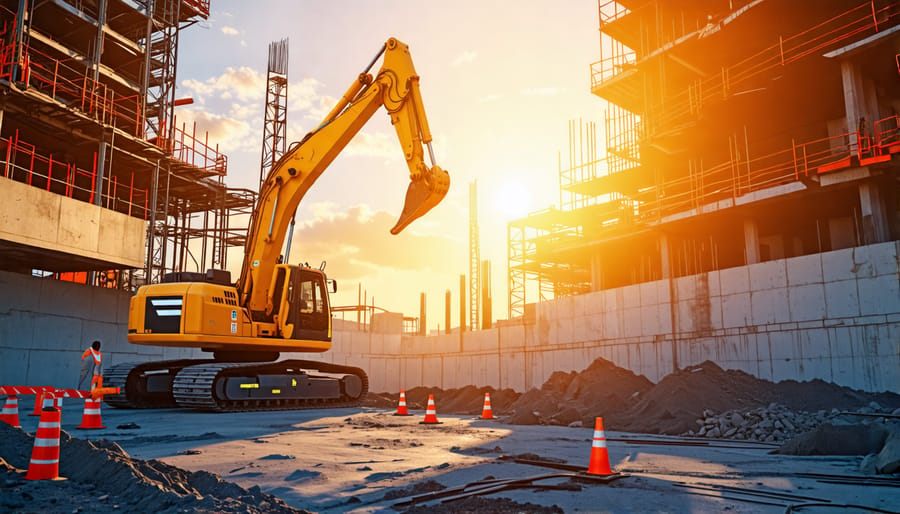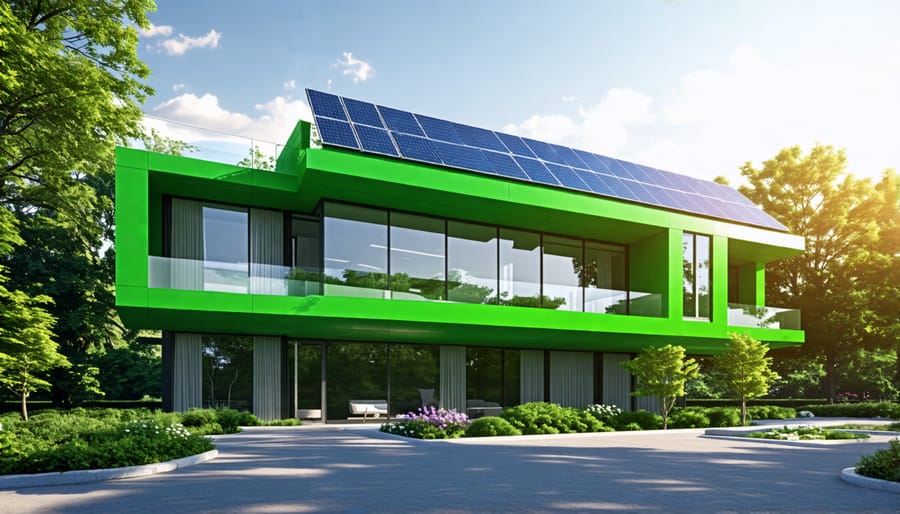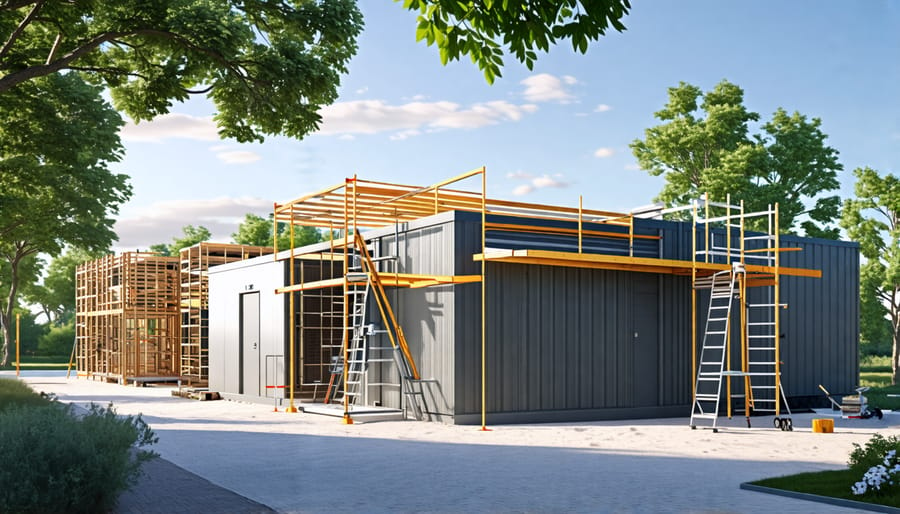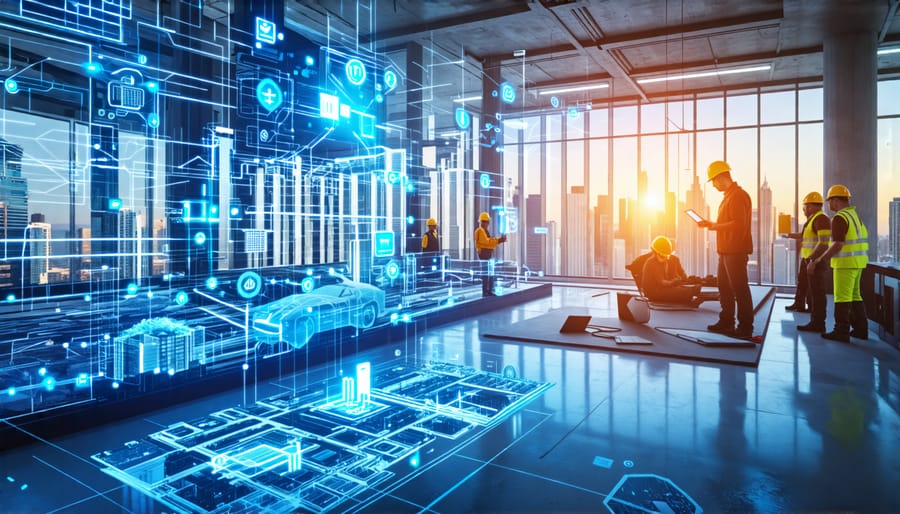Harness cutting-edge technology by investing in Building Information Modeling (BIM) to enhance project efficiency and collaboration. Stay ahead of regulatory impacts by actively monitoring changes in construction laws and codes and implementing compliance strategies promptly. Leverage insights from expert interviews to assess current industry trends and integrate innovative materials and techniques to boost sustainability and cost-effectiveness. Innovate through analyzing in-depth case studies of successful projects, identifying key strategies that can be adapted and applied to current projects to optimize results.
Current Trends in U.S. Construction

Technological Advancements
In the U.S. construction industry, technology is increasingly pivotal in transforming traditional practices, primarily through AI and automation, which are making significant strides in driving efficiency and growth. Technologies like AI in construction are enhancing project management by forecasting costs, scheduling, and labor demand with unprecedented accuracy. Automated processes are reducing on-site errors and rework, while robotic equipment and drones are offering precision in tasks such as surveying and material handling. Construction professionals and industry decision-makers are now leveraging AI-driven design tools that optimize architectural layouts and engineering plans for better resource utilization and sustainability. With in-depth case studies revealing how firms have saved time and reduced costs, the potential for technology to reshape project outcomes is substantial. Expert interviews highlight that as these technologies mature, they promise even more integration with Building Information Modeling (BIM) systems, facilitating real-time data exchange and collaboration among stakeholders. Automation isn’t just expediting construction; it’s also improving safety. AI-powered safety systems monitor site conditions and worker behavior, dynamically adjusting protocols to minimize risks. The collective adoption of these technological advancements not only speeds up construction timelines but also elevates the quality and safety of projects nationwide, signifying a promising horizon for the industry.

Sustainability and Green Building
In the ever-evolving landscape of the U.S. construction industry, the spotlight increasingly shifts to sustainability as a driving force behind modern building practices. With heightened awareness of environmental impacts, industry leaders are implementing innovative strategies that prioritize eco-friendly methods and materials. Sustainable construction is no longer an optional endeavor; it is rapidly becoming a cornerstone of industry standards. This shift is fueled by both regulatory pressures and the inherent benefits of constructing green buildings, such as long-term cost savings and enhanced occupant well-being. Central to this movement are energy-efficient retrofits, which revolutionize existing structures by integrating sustainable technologies and reducing energy consumption. These retrofits demonstrate a commitment to lowering carbon footprints while simultaneously achieving economic efficiency—a dual advantage that decision-makers are increasingly prioritizing. Case studies of successful green projects reveal a commitment to utilizing renewable energy sources, optimizing building performance through advanced HVAC systems, and employing sustainable materials. Architects and engineers are at the forefront, designing buildings that meet rigorous environmental certifications and striving for net-zero energy consumption. As sustainability becomes embedded in the construction ethos, the industry continues to explore cutting-edge technologies and collaborative approaches to build a more sustainable future.
Regulatory Changes Impacting the Industry
State-Level Regulations
State-level regulations play a crucial role in shaping the U.S. construction landscape, often reflecting local needs and priorities. These government regulations can significantly impact project timelines, costs, and design decisions. For instance, California’s strict energy efficiency and seismic safety codes aim to enhance sustainability and resilience but can also increase initial construction expenses. Meanwhile, states like Texas, with more flexible zoning laws, may offer cost advantages but face challenges regarding urban sprawl and infrastructure strain. These regulatory variations require construction professionals to stay informed and adaptable, as the implications can affect competitive bidding and project viability. Furthermore, with ongoing legal shifts, such as Florida’s evolving building codes in response to hurricane threats, understanding these regulatory landscapes is essential. This knowledge not only aids in risk management but also facilitates compliance and strategic planning, ensuring projects meet essential standards without unnecessary delays or budget overruns.
National Policies
Recent federal policies and legislative changes are significantly shaping the U.S. construction landscape, focusing on sustainability, safety, and economic growth. The Infrastructure Investment and Jobs Act (IIJA) continues to be a cornerstone, earmarking substantial funds for critical infrastructure improvements and innovations. Aimed at reducing carbon footprints, the IIJA encourages the adoption of greener building practices, potentially impacting material selection and project planning across the industry. On the safety front, updated OSHA regulations emphasize rigorous enforcement of workplace safety standards, mandating enhanced training programs to mitigate risks and ensure compliance. Furthermore, tax reforms aimed at boosting clean energy projects are incentivizing developers to integrate renewable energy sources into both new and existing structures. These policy shifts represent not just regulatory adjustments but opportunities for industry leaders to adapt, innovate, and drive sustainable growth. As these changes unfold, professionals must stay informed and agile to capitalize on emerging trends and maintain competitive advantage.
Innovative Projects and Case Studies

Case Study: The Use of Prefabrication
In the quest to enhance project efficiency and quality, the use of prefabrication in construction is increasingly gaining traction. A prime example of this innovation is the recently completed Hudson Yards project in New York City, where significant strides were made in leveraging prefabricated components. This ambitious undertaking utilized prefabrication to streamline processes, reduce build time, and mitigate site congestion, tackling one of the industry’s persistent challenges: urban construction constraints. Key among the project’s successes was the prefabrication of complex building elements off-site, including facade panels and electrical assemblies. By manufacturing these components in a controlled factory setting, the project team achieved a higher level of precision and lessened reliance on unpredictable weather conditions, leading to fewer delays and improved safety on site. The reduction of on-site labor further minimized risks associated with traditional construction processes. Interviews with project managers and engineers involved in the Hudson Yards development reveal that the decision to embrace prefabrication was driven not only by the promise of expedited timelines but also by the ongoing labor shortages in the construction sector. The integration of prefabrication is said to have shaved months off the project schedule, illustrating an effective strategy for megaprojects faced with complex logistical hurdles and high urban density. As prefabrication continues to evolve, its application is positioned to offer scalable, efficient, and resilient solutions across the U.S. construction landscape.
Case Study: Renewable Energy Integration
In the ever-evolving landscape of U.S. construction, the integration of renewable energy sources is reshaping how projects are conceived and executed. A prime example is the recent initiative undertaken by a leading Chicago-based construction firm, which embarked on the ambitious task of incorporating renewable energy technologies into a large-scale urban development. This project utilized an innovative blend of solar, wind, and geothermal energy to not only power but also optimize the overall efficiency of the development. The approach was holistic, involving early-stage collaboration between architects, engineers, and renewable energy experts to ensure seamless integration. By installing photovoltaic panels and wind turbines, the project achieved up to 60% reduction in energy costs, outperforming traditional energy systems. Geothermal systems further enhanced these savings by providing sustainable heating and cooling solutions. According to a senior project manager involved, a critical success factor was leveraging smart grid technologies to manage the energy flow efficiently, thus minimizing dependency on non-renewable energy sources. This case study exemplifies how forward-thinking construction practices can lead to substantial economic and environmental benefits, setting a benchmark for future developments. As renewable energy continues to advance, such integration paves the way for sustainable urban growth while meeting the increasing demand for green building initiatives across the country.
Expert Opinions
Challenges and Opportunities
The U.S. construction industry is navigating a complex landscape of challenges and opportunities, shaping its future trajectory. Experts point out that supply chain disruptions remain a significant hurdle, affecting project timelines and costs. Labor shortages further compound these issues, with the industry struggling to attract and retain skilled workers. However, these challenges are birthing innovative solutions, such as the increased adoption of technology to streamline operations and enhance productivity. Digital tools like Building Information Modeling (BIM) and drone technology are transforming project management, offering a way to mitigate delays and improve accuracy. Meanwhile, sustainability continues to be a driving force, presenting opportunities for businesses to adopt green building practices. The emphasis on reducing carbon footprints aligns with evolving regulatory requirements and market demand for eco-friendly construction. Additionally, public infrastructure initiatives funded by recent government policies are paving the way for significant growth opportunities. These projects not only promise to modernize aging infrastructure but also provide a platform for industry participants to demonstrate their expertise in efficient, sustainable construction practices, setting new benchmarks in quality and innovation.
Future Outlook
As the U.S. construction industry looks toward the future, several factors shape its trajectory, providing both challenges and opportunities for professionals. Advances in technology, especially in building information modeling (BIM) and prefabrication, are expected to streamline project management and enhance operational efficiency. Additionally, the growing emphasis on sustainable construction practices will drive the integration of eco-friendly materials and energy-efficient designs, potentially transforming industry standards. The regulatory landscape is also set to evolve, with potential policy shifts emphasizing infrastructure development and resilience against climate change. Industry decision-makers should anticipate adjustments to codes and compliance regulations that align with environmental and safety priorities. Interviews with industry experts highlight the increasing importance of skilled labor and ongoing workforce development, suggesting a focus on training and adopting innovative techniques. Moreover, the rise of smart cities and infrastructure is poised to create new opportunities, requiring a collaborative approach from architects, engineers, and project managers to meet the demands of a digital future. Embracing these trends will be crucial for maintaining competitiveness and driving growth in the construction sector.

